 HOME
HOMEChoose a category to view some of Mary McClelland's paintings
 Animals |
 Insects |
 Bones |
 Mosaics |
 People |
 Spiritual Paintings |
Alphabetical list of painting images |
The Life of Mary McClelland
Early years
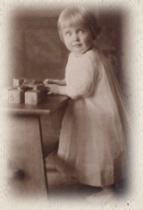
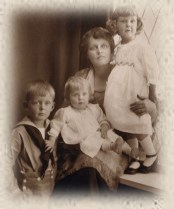 Mary McClelland was born Mary Warner Sharpless on
February 6, 1918, the youngest of three children in the
Quaker family of Grace Warner Sharpless and Thomas Kite
Sharpless. When Mary was 6 years old, her father
died of tuberculosis, leaving Grace to care for her
three young children. Within a few years, Grace
married Bernard G. Waring, also a Quaker, whose wife
had died earlier, leaving him four children. The
two families united into a power-house of energy and
Quaker values that formed the foundation for Mary's
early development.
Mary McClelland was born Mary Warner Sharpless on
February 6, 1918, the youngest of three children in the
Quaker family of Grace Warner Sharpless and Thomas Kite
Sharpless. When Mary was 6 years old, her father
died of tuberculosis, leaving Grace to care for her
three young children. Within a few years, Grace
married Bernard G. Waring, also a Quaker, whose wife
had died earlier, leaving him four children. The
two families united into a power-house of energy and
Quaker values that formed the foundation for Mary's
early development.
Now the second youngest in a family of seven children,
Mary grew up in a big house on Penn Street in
Germantown, PA within a large community of Quaker
aunts, uncles, and cousins. Most of these
relatives were members of Germantown Friends Meeting,
and many attended Germantown Friends School, as did
Mary, graduating in 1936. Mary's early life was
filled with social activities revolving around her big
family and Quaker Meeting. Her mother Gracie (as
she was universally referred to) was very devout, and
brought her children to Quaker Meetings and worship
groups several times a week. From an early age,
Mary showed a unique sense of imagination that inspired
and entertained her playmates. In his book Quaker
Meeting: a Risky Business, Mary's cousin, the
well-known Quaker educator Eric Johnson, tells this
story:
When Mary and I were about eight years old, we were climbing in a rather fragile, many-branched tree. At one point, I got a little frightened and said to my cousin, "Mary, we'd better be careful. We might fall down."
Mary replied, "Well, maybe, but we might fall up."
Young adulthood
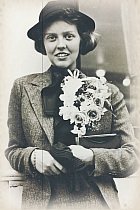 By the time she reached college
age, Mary had already become very interested in art,
though she was still unsure what she would do with this
interest. She began her college education at
Milwaukee-Downer College, but the summer after her
freshman year events unfolded that profoundly realigned
her life. Along with some cousins and
acquaintances from the Quaker community, she
participated in a Quaker work camp in Tennessee,
helping efforts by the Tennessee Valley Authority to
rebuild areas badly hit by the Depression. By
chance, it
By the time she reached college
age, Mary had already become very interested in art,
though she was still unsure what she would do with this
interest. She began her college education at
Milwaukee-Downer College, but the summer after her
freshman year events unfolded that profoundly realigned
her life. Along with some cousins and
acquaintances from the Quaker community, she
participated in a Quaker work camp in Tennessee,
helping efforts by the Tennessee Valley Authority to
rebuild areas badly hit by the Depression. By
chance, it 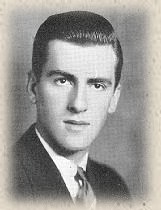 happened that David
McClelland, the son of a Methodist minister from
Jacksonville, Illinois, was also at the camp.
Mary and David fell deeply in love, and David soon came
to appreciate the spiritual depth and breadth of Mary's
Quakerism. David became a Friend by convincement,
and Mary transferred to Radcliffe College to study art
and be closer to David while he attended Wesleyan
University in Middletown, Connecticut. During
their courtship, David was welcomed with open arms into
the loving Quaker community of Mary's extended family,
and the two were married at the ages of 21 and 20 on
June 25, 1938.
happened that David
McClelland, the son of a Methodist minister from
Jacksonville, Illinois, was also at the camp.
Mary and David fell deeply in love, and David soon came
to appreciate the spiritual depth and breadth of Mary's
Quakerism. David became a Friend by convincement,
and Mary transferred to Radcliffe College to study art
and be closer to David while he attended Wesleyan
University in Middletown, Connecticut. During
their courtship, David was welcomed with open arms into
the loving Quaker community of Mary's extended family,
and the two were married at the ages of 21 and 20 on
June 25, 1938.
David and Mary McClelland's marriage was a loving and
spiritual partnership that grew steadily deeper and
stronger throughout their 42 years together. At
the time of their marriage, David was just starting
what was to become a stellar academic career in
psychology. Mary was just beginning to find
within herself the artistic and spiritual talents that
were to emerge in her unique painting style.
Together, Mary and David began a life that was to grow
in unexpected and wonderful ways, touching the lives of
many, many people along the way.
Family Life
For the first few years of their marriage
David and Mary lived in Columbia, Missouri, where David
received his master's degree, and New Haven, Connecticut,
where he did his doctorate work. With fresh PhD in
hand, David took up teaching jobs at Connecticut College,
and then his alma mater,
Wesleyan University. Settling into the rhythms of
academic life, Mary and David began their family with the
birth of their first daughter Katie in 1943. Shortly
thereafter, in 1945, identical twin boys, Duncan and
Nicholas, were born. With their springer spaniel, Willie,
the McClelland family soon became a fixture on the
Wesleyan campus, occupying faculty housing in the center
of campus on Foss Hill. Many students of that era
have fond memories of Mary, Katie, the twins, and Willie
gamboling about the campus in various combinations. Mary
certainly had her hands full with these small children,
but she took to motherhood naturally, and the family
flourished. After two miscarriages (which may well
have influenced her perceptions of death), her second
daughter Sarah was born in 1953, followed shortly by her
youngest son Jabez, in 1954.
 In approximately
1950, the McClelland family started to explore the
possibility of a summer home in northwestern Connecticut,
where David's father Clarence had purchased some land in a
community called Yelping Hill, in West Cornwall.
Mary and David soon fell in love with the place, and began
spending summers there as David worked on constructing a
home-built cabin. Mary felt very much at home in the
woods, and found that she had a deep-seated empathy for
all the living things she encountered there. Much of
her inspiration for painting animals came from the
closeness she found with nature in this rustic
setting.
In approximately
1950, the McClelland family started to explore the
possibility of a summer home in northwestern Connecticut,
where David's father Clarence had purchased some land in a
community called Yelping Hill, in West Cornwall.
Mary and David soon fell in love with the place, and began
spending summers there as David worked on constructing a
home-built cabin. Mary felt very much at home in the
woods, and found that she had a deep-seated empathy for
all the living things she encountered there. Much of
her inspiration for painting animals came from the
closeness she found with nature in this rustic
setting.
Art and Teaching
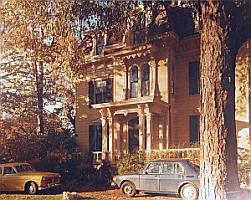 By the 1950s,
Mary's artistic impulses had started to come into
focus, and she began to experiment in earnest with
painting. In 1956, the family moved to Cambridge,
Massachusetts, where David accepted a position in the
department of Social Relations at Harvard. Moving
into a huge Victorian house at 81 Washington Avenue,
the family had space to spread out, and Mary set up a
painting studio in the basement. Soon she was
painting seriously, in between caring for her children,
and became associated with the Cambridge Art
Association, where she had several shows.
By the 1950s,
Mary's artistic impulses had started to come into
focus, and she began to experiment in earnest with
painting. In 1956, the family moved to Cambridge,
Massachusetts, where David accepted a position in the
department of Social Relations at Harvard. Moving
into a huge Victorian house at 81 Washington Avenue,
the family had space to spread out, and Mary set up a
painting studio in the basement. Soon she was
painting seriously, in between caring for her children,
and became associated with the Cambridge Art
Association, where she had several shows.
As Mary's interest in art intensified, and as her
children grew, she found that she was also developing a
strong interest in art education. This interest
blossomed when she and David joined a group of Quakers
from Cambridge Friends Meeting who were interested in
starting a Quaker school. In 1961 they founded
the
Cambridge Friends School, selecting Mary's brother
Tom Waring as the first headmaster. Mary became
the art teacher, and soon she found unfolding within
herself a unique approach to teaching art, based on
seeing, that deeply touched the lives of many of
her students. A glimpse of her approach can be
found in this pamphlet
she wrote about some of her teaching experiences.
Travel
Along with David's rising fame as a
psychologist came opportunities for travel, which Mary
and David took up with enthusiasm. Beginning with
a summer seminar in Salzburg, they visited Europe
several times, including a 10 month stay in Florence in
1959 with their children Katie, Sarah, and Jabez.
1960 brought a summer in Tepotzlan, Mexico, near
Cuernavaca, where David and Mary rented a hacienda with
Duncan, Nick, Sarah and Jabez. This was Mary's
first encounter with a third world culture, and it
proved to be a turning point for her art.
Something about the Mexican attitude toward death - a
certain matter-of-fact acceptance and at the same time
a fascination - resonated with Mary, and she began to
see more clearly the paintings she was going to
create.
In 1963 David took a sabbatical, and he and Mary went
with the two younger children to Tunisia for nine
months while he did research for the Ford
Foundation. On the way to Tunisia, they took a
world tour, stopping in Japan, Hong Kong, Thailand,
India, and Kenya before heading to North Africa.
On another sabbatical in 1968, Mary and David chose
Ethiopia as their destination, with another circuit
around the globe on the way. This time they
stopped in Fiji, Australia, Thailand, India, and East
Africa before settling in Addis Ababa for five
months. In all these places, Mary spent most of
her time exploring the countryside, filling sketch
books with hundreds of interesting people and animals
that she saw.
With the growth of their children, Mary and David soon
took seriously to traveling, making countless journeys
to nearly every corner of the globe. Stimulated
mainly by David's interest in applying his
psychological theories on achievement motivation to
developing third world economies, but also by Mary's
love for taking in the sights, sounds and smells of
foreign cultures, they spent time in the Caribbean,
Peru, South Africa, East Africa, West Africa,
Indonesia, India and Sri Lanka. In Africa, Mary
particularly loved the game parks, with their graceful
animals and fierce predators. She found something
there that spoke to what it was she was trying to bring
out in her paintings - something about the relationship
between God, life, and death:
"The plains are spotted with carcasses - ribs - skulls - bones and skins and legs - no dilly dallying about death - it comes swiftly and uncompromisingly, and there are no reprieves. It's clean, clear - like the air here - but it's not man's way. I've been taking photos of carcasses as well as animals. The secret is somewhere here - I want to find it."
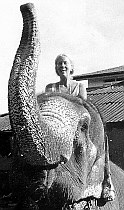 Of all the countries Mary visited, she seemed to
develop the deepest relationship with India and Sri
Lanka. During another sabbatical in 1971, David
and Mary lived for six months in Sri Lanka, where Mary
became entranced by elephants. They lived in a
guest house that had working elephants, and Mary had
ample opportunity to get close to them. When she
returned to the US she generated a series of pen and
ink drawings of elephants that are considered by some
to be her best work - marvelously depicting the
playfulness, power, and mystery of these creatures.
Of all the countries Mary visited, she seemed to
develop the deepest relationship with India and Sri
Lanka. During another sabbatical in 1971, David
and Mary lived for six months in Sri Lanka, where Mary
became entranced by elephants. They lived in a
guest house that had working elephants, and Mary had
ample opportunity to get close to them. When she
returned to the US she generated a series of pen and
ink drawings of elephants that are considered by some
to be her best work - marvelously depicting the
playfulness, power, and mystery of these creatures.
Both in Sri Lanka and India, Mary also learned first
hand about the spiritual teachings of Buddhism and
Hinduism, which had a profound effect on her
life. Absorbing such things as the
Perahera festival, with its lightbulb-draped
elephants (which Mary filmed extensively), and the
multitude of temples and holy places from South India
to the Himalayas, Mary deepened her spirituality, and
found new directions for her art.
Community and Spiritual Growth
One of the most prominent features of
Mary's life was her sense of community and the
connections she felt with so many people.
Starting in the early 1960s, Mary and David began
letting foreign exchange students live in spare
bedrooms in the huge house at 81 Washington Avenue in
return for chores. Mary really loved taking these
students in and learning about their cultures, and she
and David liked the feeling of a busy, active household
that the extra people brought. As the 1960s
progressed into the 1970s, the practice of taking in
foreign students extended to friends of Mary and
David's children, David's psychology students at
Harvard, and eventually just people with whom Mary and
David felt connected.
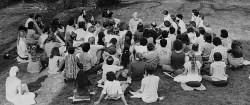 About that time, one of David's most remarkable
students, Richard Alpert, returned from India as Baba
Ram Dass, having spent a number of years on an ashram
devoted to the guru Neem Karoli Baba. Through the
connection with Ram Dass, Mary and David's house soon
became a landing place for people returning from India
at various stages of their spiritual journeys.
Taking these people into her home seemed very natural
to Mary, and what resulted was a spiritual community at
81 Washington Avenue that
About that time, one of David's most remarkable
students, Richard Alpert, returned from India as Baba
Ram Dass, having spent a number of years on an ashram
devoted to the guru Neem Karoli Baba. Through the
connection with Ram Dass, Mary and David's house soon
became a landing place for people returning from India
at various stages of their spiritual journeys.
Taking these people into her home seemed very natural
to Mary, and what resulted was a spiritual community at
81 Washington Avenue that 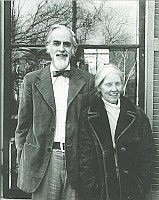 developed and grew in many
directions. Mary and David never gave up their
Quaker roots, attending Cambridge Friends Meeting
regularly, but saw the rich traditions of India as a
way to deepen and broaden the spiritual paths they were
following through Quaker worship. They also
explored other spiritual paths, and spent time with a
number
developed and grew in many
directions. Mary and David never gave up their
Quaker roots, attending Cambridge Friends Meeting
regularly, but saw the rich traditions of India as a
way to deepen and broaden the spiritual paths they were
following through Quaker worship. They also
explored other spiritual paths, and spent time with a
number
 of holy men ranging from the Tibetan Buddhist
teacher Chogyam Trungpa Rinpoche to a local healer
named Karmu. One of Mary's favorite teachers was
Hugo Maier, a homeopathic doctor from Germany who had
spent many years in India with the guru Sri Ramana
Maharshi. Hugo had become a spiritual teacher
himself, and Mary and David spent many summers in
Switzerland, and winters in Tiruvannamalai, India,
participating in spiritual workshops with him.
of holy men ranging from the Tibetan Buddhist
teacher Chogyam Trungpa Rinpoche to a local healer
named Karmu. One of Mary's favorite teachers was
Hugo Maier, a homeopathic doctor from Germany who had
spent many years in India with the guru Sri Ramana
Maharshi. Hugo had become a spiritual teacher
himself, and Mary and David spent many summers in
Switzerland, and winters in Tiruvannamalai, India,
participating in spiritual workshops with him.
Death
In 1978, stomach problems that had
been bothering Mary for some time were diagnosed as
gastric cancer. While the news had a profound
effect on Mary's family and all the people she was
connected with, Mary herself seemed to take it with a
certain equanimity. After all, she, more that
anyone else, had been coming to terms with death for
many years through her paintings of dead animals and
bones. Perhaps she saw her impending mortality
not so much as something to be feared but as a natural
step and an opportunity for spiritual growth.
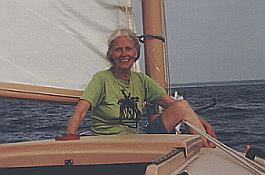 After surgery, Mary recovered her health for a period
of time and spent much of her energy connecting with
the people she loved. Towards the end of 1979,
though, her health deteriorated again, and she slowly
and gently prepared for death. Eschewing nearly
all interactions with hospitals and doctors - her
cancer was at this point not treatable by standard
medical practices anyway - Mary stayed at home and
gradually became thinner and thinner, all the while
comforting and calming the many people around
her.
After surgery, Mary recovered her health for a period
of time and spent much of her energy connecting with
the people she loved. Towards the end of 1979,
though, her health deteriorated again, and she slowly
and gently prepared for death. Eschewing nearly
all interactions with hospitals and doctors - her
cancer was at this point not treatable by standard
medical practices anyway - Mary stayed at home and
gradually became thinner and thinner, all the while
comforting and calming the many people around
her.
By the Fall of 1980 Mary had become extremely weak and
was suffering no small amount of pain and
discomfort. Nevertheless, she maintained a
positive outlook, and was able to go through all of her
paintings with her friends Ruth Stokes and Russ
Windman, cataloging and commenting on them (most of the
quotes in this website come from a transcript of those
conversations). As November moved into December,
David reported several times that he awoke in the
morning to hear Mary murmuring "It's so
beautiful..." in the moments before she was fully awake
and aware of her uncomfortable body. On December
12, 1980, Mary finally stopped returning from that
place where it was so beautiful, and died peacefully in
her sleep.